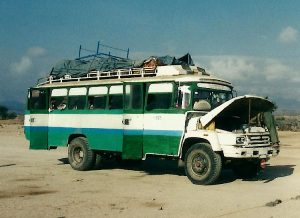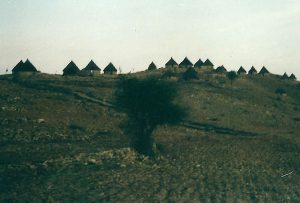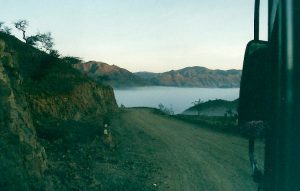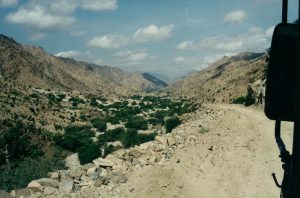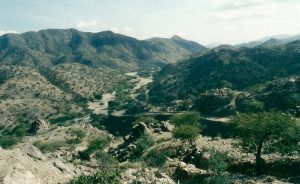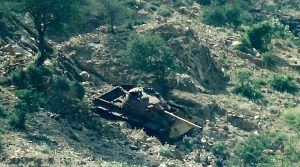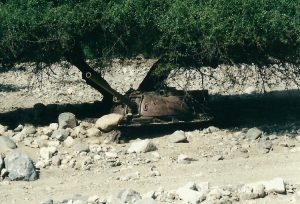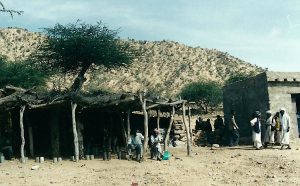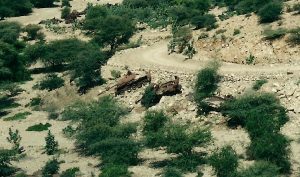
Keren & Nacfa
Mon 11th. Time for some bus travel – to the second city of Keren. At the bus station it was a bit of a scrap to get on but as an honoured foreigner I was shown to a seat. In Keren I checked in at the Sicilian Hotel, a pleasant hotel with an attractive courtyard bedecked in bouganvillea, in fact I had noticed a lot of this growing in Asmara as well – it brought some colour to an otherwise arid and colourless landscape. The only other guest at the hotel was a rather excitable Italian surgeon who had been working there for about 18 months.

The following day I had a more traditional breakfast which reminded me of the usual fare I’d eaten in Cairo – fuul with onions and tomatoes. I noted that the locals were rather indifferent to me so I was able to take quite a few photos, especially at the wood market which took place in the dried up river bed in the centre of town. Here the sellers were gathered with a variety of donkeys and camels with wood on their backs for sale.






I also went to the Keren war cemetery (obviously Eritrean towns don’t have that many places of interest!). Again it was extremely well maintained and the caretaker showed me a book written in 1957 describing all the battles fought in the area and listing the dead in the cemetery. Beyond this I walked to the shrine of St. Mary Dearit which is a carved statue of the Saint inside a very old Boabab tree.







Like most towns in Eritrea, Keren also has its fair share of half decent bars serving half decent beer – Melotti. I presume it was the same beer I was drinking all over Eritrea as I never saw a single label! I did have one unnerving moment however as one of the old guys in the bar stumbled off his chair, accosted the barman and started pointing at me. Bloody drunk I thought. However he turned into my best mate when I realised he was attempting to pay my bar tab. He and a few of the other blokes in the bar then implored me to head off from Keren to Nacfa.
Nacfa is famed throughout Eritrea as the symbol of resistance to the Ethiopian occupation. During the war every building except the mosque was completely obliterated by constant bombardment. I suppose I had to see it for myself. I wasn’t too keen as I knew the road to Nacfa followed a dried up river bed for most of the way but I headed off nonetheless.
I was soon to find out the road WAS in fact a dried up river bed. While my bones shook along this track my friendly companions kept my mind off my arse by readily pointing out landmarks from the war for independence. One of these was the village of Afabet. Today it is a barren wasteland with a few shacks, but formerly it had been a large barracks town where in one battle for independence 18,000 Ethiopian soldiers were killed. Further on, a beautiful canyon was pointed out as the site of a famous tank battle. Many of their rusting carcasses are still visible. Further still we stopped for coffee at a shack where all the stools were shell casings. Tellingly, the shell casing stools felt more comfortable than the bus seats.
Not surprisingly there wasn’t much to see in Nakfa. however, I bumped into a couple of Red Cross Delegates (as they call them) at the only restaurant in town and they gave me the rather disturbing news that three anti-tank mines had recently gone off killing some civilians in Agordat and there had been abductions of Europeans in Tesserai – both places I intended to visit.



The following day I was up early for the return trip to Keren. I was told the bus was leaving at 4am! I was actually the first passenger there and had to wake the driver up. At least I got prime spot in the seat next to the driver. Unfortunately the trip was so bumpy I had no chance of taking any photos of the incredible landscape. Back at the Sicilian Hotel I eased my bones into a hot bath and cooled my head with a cold beer ready for tomorrow’s journey due east to the Sudanese border and the possible troubles that lay ahead.
